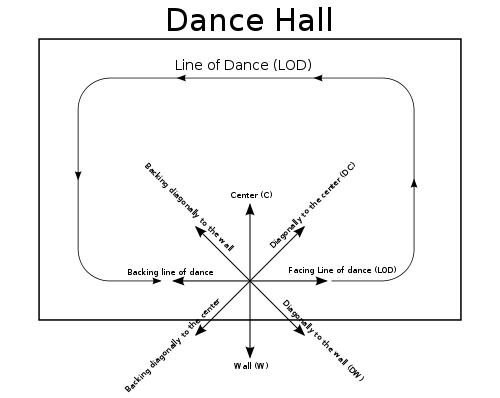- Direction of movement
-
In ballroom dancing (as well as in other types of partner dance), directions of (progressive) movement, in particular, directions of steps, can be indicated either in relation to the room or in relation to the body position. Directions of turns, although there are only two of them, may also be indicated in several ways.
Contents
Directions of progressive movement
Basic directions of movement with respect to the room
- along the LOD (line of dance)
- against the LOD
- to the center
- to the wall
- diagonally to the center (DC)
- diagonally to the wall (DW)
- diagonally to the center against the LOD (DC against LOD)
- diagonally to the wall against the LOD (DW against LOD)
These directions may be taken either facing or backing. For example, "backing DC against LOD".
Basic directions of step with respect to body position
These are described in one of the following ways.
- By compass points: Assuming that the dancer faces North at any moment, one may say, e.g., "take a step North-West".
- By clock: Assuming that the dancer stands at the center of a clock with hands and faces 12, one may say, e.g., "take a step at two o'clock".
- With respect to the line of the supporting foot, the next step may be placed
- forward,
- back,
- sideways,
- diagonally forward,
- diagonally back,
- forward and across,
- back and across.
- A more detailed diagram of step directions of this kind can be found at ballroomdancers.com
Directions of turns
The direction of a turn is indicated in one of the following ways.
- Clockwise (CW) vs. counterclockwise (CCW) turns.
- Right vs. left turns.
- Natural vs. reverse turns.
- Inside vs. outside turns.
While the first two ways are fairly straightforward, the third one requires some explanation, and the fourth one is often a source of confusion.
Natural vs. reverse turns
The term "Natural turn" describes a right turn. This usage originated from the names of Waltz and transferred to other dances of similar category.
A "natural" theory of the origin of the term is that considering the right-shifted position in a couple (even more pronounced in older times) and the counterclockwise direction of travel along the line of dance, the right turns are easier to perform, they are more "natural". This is especially true at the corners of the LOD: the amount of the right turn is effectively 3/4 of a full turn, and the amount of the left turn is effectively 5/4, because the LOD changes its direction by 90 degrees to the left (CCW).
Inside vs. outside turns
The terms are applied to an individual turn of a partner in the couple. Basically, an "inside turn" denotes a turn where the arm of the partner doing the turn begins by moving towards the "inside" of the couple (the line running from the center of one partner to the center of the other); "outside turn" is analogous. The meaning is intuitively clear, but it may be performed in numerous ways and in different handholds, so that even accomplished dancers are confused. In dances such as swing and salsa, inside and outside turns most commonly refer to underarm turns done by the follower. Since in these dances the follower's right arm is normally used to lead a turn (most commonly by the leader's left arm, but sometimes by the leader's right arm when a cross-hand or "handshake" position is used), an inside turn is normally a left (counter-clockwise) turn, while an outside turn is a right (clockwise) turn. However, if the follower's left arm is used to initiate the turn, the intended direction of turning may be opposite.
A term such as "inside turn" is most intuitively clear if initially the couple is in an open single-handhold position facing each other, and the name corresponds to the direction of the lead. To lead the inside turn, the leader moves the follower's arm "inside". The similar rule holds for the "outside". When the position is significantly different, the term is not so clear.
Therefore in some dances some prefer to use this term according to its usage in ballet, based on the footwork, rather than arm style. In ballet, when describing pirouettes, an outward (en dehors) turn is the turn in the direction towards the working leg. Accordingly, an inward (en dedans) turn is the turn in the direction towards the support leg. See also Ballet glossary#Ronds de jambe.
Although the latter definition has the benefit of unambiguity, its drawback is that in other contexts it is applicable to a single footstep only. For example, according to this definition, the Chaines turns is an alternating chain of inside of outside turns, although the direction of the rotation is the same. Therefore it is common to name the turning figure according to the direction of the first turning step.
Concluding, the terms "inside/outside turn" should be read only in the exact context of the dance, and possibly, the particular dance school.
See also
Glossary of ballroom dance terms - Dance basic topics
Categories: Partner dance technique
Wikimedia Foundation. 2010.

